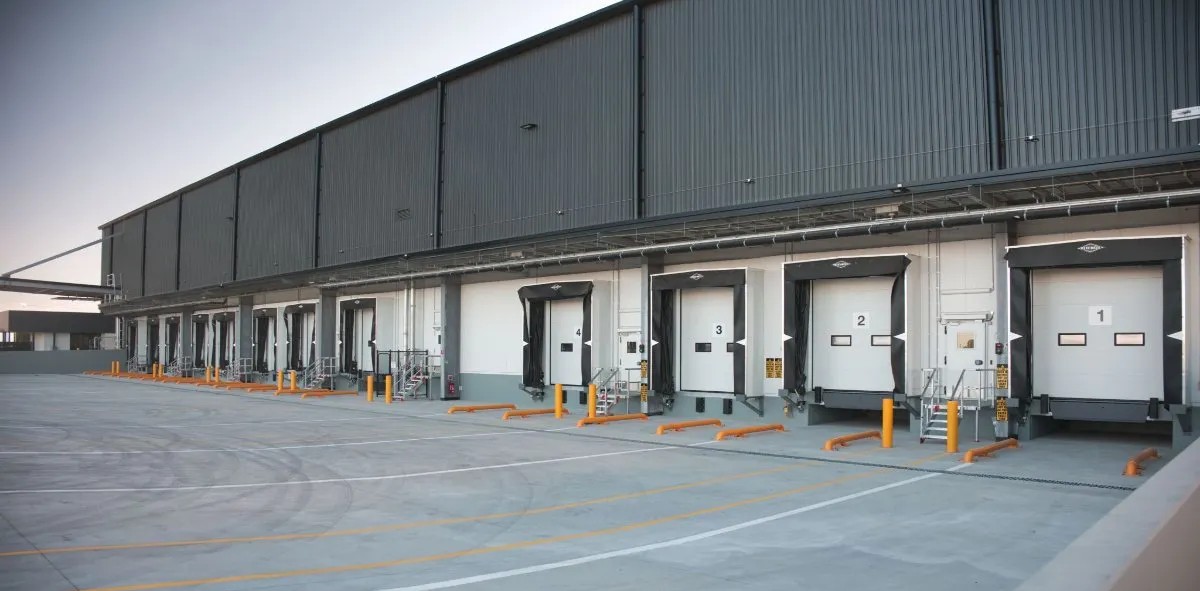Scantec provides centralized low-charge ammonia system for poultry distribution warehouse in Western Australia
February 13, 2024

Scantec Refrigeration Technologies has provided a centralized low-charge ammonia/NH3 (R717) refrigeration system for a new poultry warehouse near Perth, Australia, that it says offers an estimated annual energy savings of approximately 30% compared to “a conceptually identical liquid overfeed system.”
This figure was relayed by Managing Director Stefan Jensen to Ammonia21.com via email, with Jensen citing a documented estimate from a technical paper he authored for the International Institute of Ammonia Refrigeration (IIAR)’s annual meeting in 2022.
“For this plant layout, the estimated annual energy saving is approximately 30% for the centralized low-charge NH3 system compared with a conceptually identical liquid overfeed system,” said Jensen. “The estimate is valid for a facility with [refrigerating] plant room on the ground, ceiling suspended evaporators and refrigerant pipelines/valve stations located in the ceiling space.”
Jensen said the new distribution center has roughly 73,000m3 (2,577,971ft3) of refrigeration space and that the ammonia system has a full charge of approximately 750kg (1,653lbs). In a recent LinkedIn post, the Australian OEM said the distribution center has a room height of 11m (36ft). It is owned by logistics company Logos, which has leased the facility to Ingham’s, the largest poultry producer in Australia and New Zealand.
“Our most recent low-charge ammonia system not only stands as a testament to our commitment to environmental sustainability but also serves as a wise financial investment, offering substantial energy savings and operational efficiency improvements poised to shape the future of refrigeration technology,” said Scantec.
Scantec writes on LinkedIn that the low-charge system has a cooling capacity of 350kW (99.5TR), with 150kW (42.7TR) of capacity used for the facility’s bespoke in-rack blast freezing system and 200kW (56.9TR) of capacity dedicated to maintaining a temperature of −22°C (−7.6°F) in the cold storage room. The company said four GEA V110 reciprocating compressor packages provide the “heart” of the system.
“These packages [offer] a low total cost of ownership [and] also boast superior reliability and minimal energy consumption,” said Scantec.
Scantec projects the refrigerated operations to have a specific energy consumption (SEC) of 16‒17kWh/m3/year (0.45‒0.48kWh/ft3/year). The company did not include blast freezing in its SEC calculations, but Jensen did provide an estimate.
“The blast freezing quantity varies and the quantity frozen is not disclosed by the facility user,” said Jensen. “Based on the facility freezing 300 metric tons [300,000kg] per week, it is estimated that this will add approximately 10‒12kWh/m3/year [0.28‒0.33kWh/ft3/year] to the SEC.”
In its LinkedIn post, Scantec notes the “energy performance enhancements” attained by its centralized low-charge ammonia system over liquid systems can be attributed to:
- The elimination of all liquefied refrigerant in all suction lines and risers
- Improved part-load compressor efficiency from “judicious” compressor selection, the “meticulous” control of rotational compressor speed and by setting optimal rotational speed ranges
- The incorporation of variable frequency drives across the board
- Improved condenser liquid drainage mechanisms to enhance energy efficiency
Jensen estimated a capital cost premium for the system at 5–7% compared to a liquid overfeed system due to its specific design and the inclusion of HBX injection control.
Up to 73% more efficient
Jensen provided performance data for a low-charge ammonia system operating in a larger refrigeration plant with 248,000m3 (8,736,520ft3) of refrigerated space, which is also owned by Logos. The design and performance of the system, commissioned in June 2022 in Melbourne, was documented in a study authored by Jensen and presented by him at the Ohrid NH3/CO2 2023 Conference in Ohrid, North Macedonia.
Using 1,000kg (2,205lbs) of ammonia, the centralized low-charge system provides 885kW (251.6TR) of low-temperature capacity and 358kW (101.8TR) of medium-temperature capacity, with the blast freezing refrigeration capacity representing 379kW (107.8TR). Performance data from mid-June to mid-July 2022 showed an SEC of 11.7kWh/m3/year (0.33kWh/ft3/year).
According to the study, from 1999 to 2013, Logos constructed and operated large-scale liquid overfeed ammonia refrigeration plants using dual-compression with screw compressors across Australia. The systems employed energy efficiency measures such as variable frequency drives, oversized condensers and evaporators, and “smart” compressor sequencing. The company also employed a full-time energy manager.
In comparing the data from the plants using conventional liquid overfeed and the new low-charge system, the study found a sizable energy performance improvement potential for the low-charge setup.
“In this case, for this refrigerating plant design, for this refrigerated volume and this mix between medium- and low-temperature rooms, that improvement potential is around 73%,” Jensen wrote. “Of course, this is not a universal improvement available in all cases.”
In a presentation at the ATMOsphere APAC Summit 2022, organized by ATMOsphere, publisher of Ammonia21.com, Jensen said that low-charge ammonia systems can significantly reduce energy consumption and operating costs of cold storage facilities compared to HFC-based systems. Awareness is very important for wider adoption, he noted.
ATMOsphere’s 2023 Market Report found that the use of low-charge ammonia systems is growing in Europe and North America.


